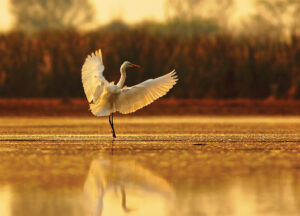By Raya Pruner
 In 1900, Frank M. Chapman of the freshly formed Audubon Society proposed a new holiday tradition that would promote conservation by counting, rather than hunting, birds on Christmas Day. Then, he called it the “Christmas Bird Census” and that first year managed 25 counts thanks to the efforts of 27 focused birders (they counted about 90 species that first year). Over the years, this bird census has come to be known as the Christmas Bird Count (CBC), and it’s the nation’s longest-running community science bird project. Over the past century, these bird counts have helped biologists, researchers, wildlife agencies and avid birders study bird populations across North America. In fact, the idea of an annual bird count has spread and now takes place in over 20 countries across the Western Hemisphere including far-flung locales like Saipan and Guam to the west, and Paraguay to the south.
In 1900, Frank M. Chapman of the freshly formed Audubon Society proposed a new holiday tradition that would promote conservation by counting, rather than hunting, birds on Christmas Day. Then, he called it the “Christmas Bird Census” and that first year managed 25 counts thanks to the efforts of 27 focused birders (they counted about 90 species that first year). Over the years, this bird census has come to be known as the Christmas Bird Count (CBC), and it’s the nation’s longest-running community science bird project. Over the past century, these bird counts have helped biologists, researchers, wildlife agencies and avid birders study bird populations across North America. In fact, the idea of an annual bird count has spread and now takes place in over 20 countries across the Western Hemisphere including far-flung locales like Saipan and Guam to the west, and Paraguay to the south.
Audubon maintains an interactive map with all the different CBC locations and contact\for each here: https://audubon.maps.arcgis.com/apps/View/index.html?appid=ac275eeb01434cedb1c-5dcd0fd3fc7b4C.
So, what exactly is a bird count? The CBC is an early-winter bird census where thousands of volunteers that make up different “circles” go out between December 14 to January 5 every year. Each circle, like Choctawhatchee Bay, will choose a single calendar day within those dates to count birds. Count volunteers follow specified routes through a designated 15-mile diameter circle, counting every bird they see or hear all day. (Helpful hint Okaloosa and Walton County residents: a pair of binoculars makes an excellent Christmas gift). However, the count is not just a species tally—all birds are counted all day, giving an indication of the total number of birds in the circle that day. Now in its second century, the CBC has evolved into more than a seasonal tradition.
The CBC data represents one of the only conservation tools available for assessing the long-term trends in bird populations of North America. To date, over 300 peer-reviewed articles have resulted from use of CBC data. It was also used as a basis for Audubon’s 2014 report on the impact changing global temperatures are having on bird populations (you can see this fascinating report at www. audubon.org/climate/survivalbydegrees) and was instrumental in the collaborative development of the report by the North American Bird Conservation Initiative and U.S. Fish & Wildlife Service. (Learn more at https://archive.stateofthebirds.org/state-of-thebirds- 2009-report). Closer to home, the Choctawhatchee Bay circle encompasses parts of Fort Walton Beach, Destin, Shalimar, Valparaiso, Niceville and Eglin AFB. The CBC Count Day for Choctawhatchee Audubon was December 18 where the tradition continued, but with some modifications to support a COVID-19 safe and socially distanced CBC.
Birders of all skill levels can volunteer in the CBC. If you are a beginning birder, you can be paired with local experts and if your home is within the boundaries of a CBC circle, then you can stay at home and report the birds that visit your feeder or yard on count day as long as you have made prior arrangements. Hot bird tip: If you’re just getting into birding, the free Audubon Guide to Birds in the app store is a great resource, as is Merlin Bird ID by Cornell Lab, part of Cornell University; recently, Merlin has added a Sound ID feature so you can identify birds near you based off their tweets. Another favorite is iBird Pro Guide to Birds, although that one isn’t free.
Malcolm Swan and Bruce Purdy coordinate the Audubon CBC circle in this worldwide citizen science event. The 15-mile-diameter circle is centered four miles North of the Marler (Destin) Bridge over East Pass, and the circle is divided into many sections for the different parties of observers. If you missed it this year, visit www.choctawhatcheeaudubon.org to download a pdf with bird ID tips and be ready for the 2022 Bird Count!
CAS hosts a number of outings each year. These include many bird walks, field trips, Fall and Spring Migratory Bird Counts, the Christmas Bird Count and a spring chapter retreat. Each year, special projects provide a chance to get outdoors and give back to the community at the same time. Last year, CAS volunteers monitored rooftop Least Tern nests and conducted a marine debris survey on Eglin AFB beaches. The Choctawhatchee Tern Team will resume nest monitoring operations in March.
The Choctawhatchee Audubon Society is a chapter of the National Audubon Society and is a non-profit, volunteer organization serving Okaloosa and Walton Counties (since 1976). For more information or questions, contact Malcolm Mark Swan at malcolmmarkswan@gmail.com. Information on all available count circles can be found at www.Audubon.org. Check the website for upcoming field trips and programs in 2022.






























































